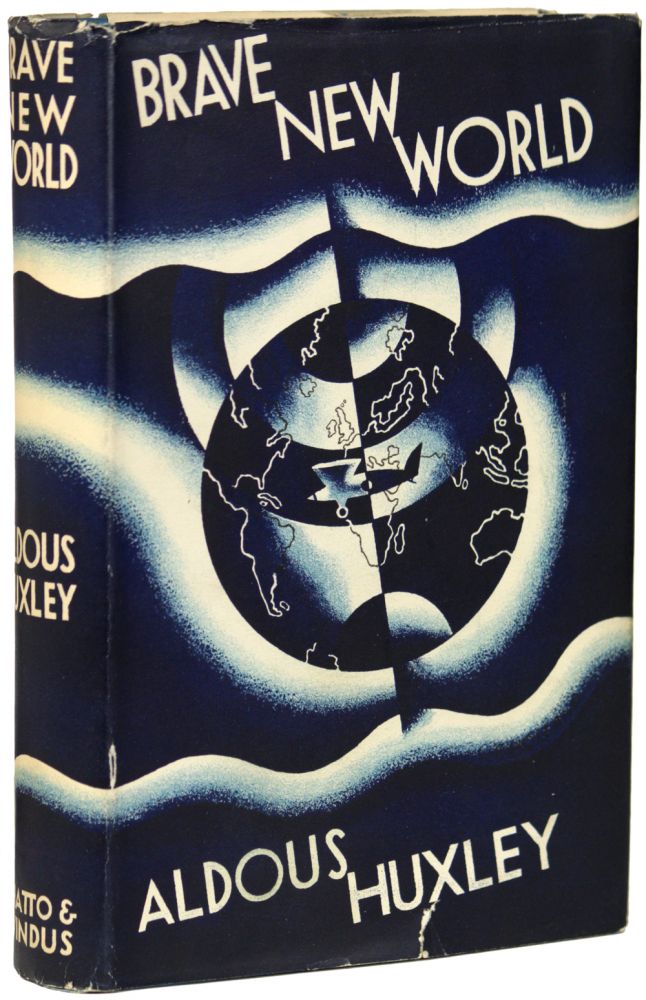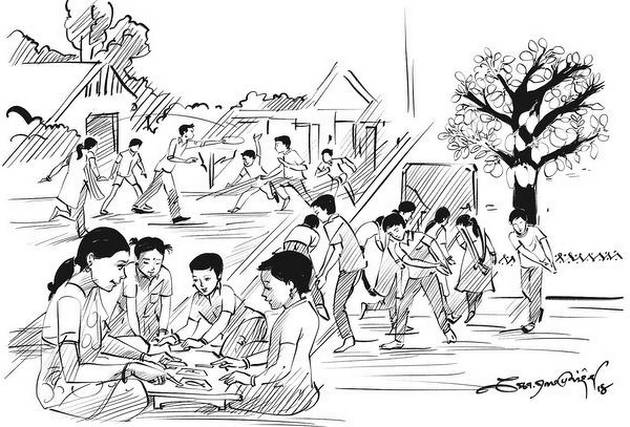- Visitor:35
- Published on:
Indian Influences in developing Aldous Huxley’s Thought: Part II
In Hinduism, dying is an art. In the higher reaches of Yoga, one can choose at will when to quit and where to go. Under certain circumstances, voluntary death – prâyopaveSaNa, sallekhana or santhârâ – is admitted. The art of dying however is the same as the art of living. Noble life and noble death go together.

….continued from the last part
Bridge-Building
But to arrive at this conclusion, Huxley had to traverse a long road. First he had to overcome, in his own, thinking the powerful bias of the age: world’s essential materiality and meaninglessness. He took the first step by recognizing a plurality of dimensions; he thought that the world exists on many planes and in many modes, each on its own, and the problems was to bring these different planes in some sort of unity or at least relationship. In Those Barren Leaves, Calamy, a philosophical character, reflects on his own hands, of course while in bed with Miss Thriplow – perhaps a novelist’s device to make philosophy living and even loving; he speculates that his hand exists in many modes: electromagnetically as a structure of molecules; biologically as part of a larger living organism; amorously as at that moment with power to excite and exhilarate; ethically when it does good and executes evil. “Universe on top of universe, layer after layer, distinct and separate.” In these early novels, Huxley, through his characters, is very much occupied with “bridge-building”, in synthesizing these multifarious universes in one grand philosophy.
After he came under the Indian influence, he saw his universes and his task differently. He saw two orders, saMsâra and nirvâNa, as being different and yet the same. There is a Godhead, Brahman, Clear Light of the Void which is the Unmanifest principle of all manifestations, which is at once transcendent and immanent. Both are held together in a mystic vision, in the unity of consciousness, in an act of unitive knowledge. Both are at heart the same. This is also That. The soul is akin to God and it can grow into his likeness.
Passionate Life
In his early writings, Huxley had no use for thinkers and moralists who talked of “true” selves and ‘true’ Gods, who preached that men should shape their lives in their image. He opposed the “stoic’s brutal sacrifice of the physical, instinctive and passionate life” and “the ascetic’s selfcastration”. He said that aspiration for a “consistent perfection” was “aspiring towards annihilation”. And then praising the Hindus where the praise was not due, he said that they “had the wit to see and the courage to proclaim the fact” that “Nirvana, the goal of their striving is nothingness”. Later on, he had a different view of NirvâNa. At this time, he held the current scientific view that man was no more than a physical-biological being and the spiritual dimension tended to be neglected or it was equated with the intellectual and artistic faculty. Therefore he came to the eminently reasonable view that a man should be what he really is and should not try to be different. If man was a worm in reality, he should not try to be a butterfly. “Fate has decreed that we shall be worms; so let us resign ourselves to being worms; nay… let us be worms with gusto, strenuously; let us make up our minds to be the best of all possible worms. For, after all, a good worm is better than that nondescript creature we become when we try to live above our station, in the world of wings. No amount of trying can convert a worm into even the worst of butterflies.” Partly at least, this view was a revolt against so many theologians, moralists and utopians who were around and, who in the name of a “consistent perfection” and an “ideal” society and an “ideal” man, exercised great tyranny. The theologians taught that there was no good in man and yet he should do good4 and then dictated what that good was. Huxley’s ideas on human goodness, aspiration and perfection changed when his view of man changed, when he realized that man is secretly good and divine.
Multiple Selves
In his earlier novels, Huxley teaches the gospel of “noble savagery”; he wants man to be a “life-worshipper”. Man should learn to live not only mentally but also “viscerally”; he should admit not only the claims of his heart and mind but also claims of “the bowels, the loins, the bones and skins and muscles”. Huxley’s own constitution was highly intellectual and ascetic. In his essay Squeak and Gibber (Music at Night), he says that he finds the life of pleasure boring and painful, that it has do with his temperament, not any ethical theory. Probably pretty girls attracted him, but he found them boring – nothing wrong morally but spiritually raw, bothersome and uninteresting. Therefore, many of his characters even while in the midst of a passionate love-affair find it a “dreary and fatiguing routine”. They remain also aware of another dimension, the dimension of the spirit which they would like to plumb if they were free from their present obsession. However the spirit is willing, the flesh is weak. Weak in pain but still weaker in pleasure, they reflect. Therefore, he developed an ethical theory which had room both for instincts as well as the intellect. He said that man is not one but multiple; He is not one self, but a colony of selves. He must live all his selves and all his parts, and live them not moderately but fully. In his essays on Pascal and Spinoza’s Worm both included in his anthology, Do What You Will, published in 1929, he developed the theory of “balanced excess”. He preached that the life-worshipper of his conception would be “at times a positivist and at times a mystic; derisively sceptical and full of faith”; he will be “by turns excessively passionate and excessively chaste”; he held that “all the manifestations of life are godlike, and every element of human nature has a right – a divine right, even – to exist and find expression.” He said, quoting Pausanias in the Symposium of Plato, that “all the Gods ought to have praise given to them.” Plato had also described such a man who was sensualist and ascetic alternately, who fasted one day and gormandized the other. But according to him, this life was chaotic and it belonged to one who had no metaphysical and moral standards left, and whose soul was heading for a tyrannical life. Under the influence of Indian religion and philosophy, Huxley also radically changed his view-point. He gave up the doctrine of the “multiple man” and embraced the one of the “higher man”. Probably he still remained a “life-worshipper”, but under a very different definition. Life now meant life of the soul, higher life, immortal life. He came to believe that “enlightenment is the supreme end of man”, the highest purushârtha of Hindu thought. In Ends and Means, an early work written under Hindu-Buddhist influence, he said that “the ideal man is the non-attached man. Non-attached to his bodily sensations and lusts. Non-attached to his craving for power and possession. Non-attached to the objects of these various desires. Non-attached to his anger and hatred; non-attached to his exclusive loves. Non-attached to wealth, fame, social position…”

Spirit and Body
On purely materialist principles, a life even when lived “fully” – as the word is understood – has little meaning. Its best accomplishments are a mere vanity and vexation of the spirit. There is even less to justify the lives of the poor. Huxley once shared these views. Like the rest of his intellectual community, he believed in one life. No after-life, no rebirth, no resurrection. While in India in the mid-twenties, he asked himself the question – to what end millions upon millions of people are born and painfully live? He was honest enough to admit that it is hard enough to find a reason anywhere, West or East. But in India, he thought, there was no conceivable answer to the question, at any rate in terms of the present existence. And therefore, he added, “Metempsychosis had to be invented, and the doctrine of karma elaborated with a frightful logic, before the serried, innumerable miseries of India could be satisfactorily accounted for.” The explanation was in the spirit of sciences of the day. Huxley was never a thorough denier. He recognized the Spirit and its life, but he identified it with Intellect, or with aesthetic or with art. It was also thought to be at the mercy of the body. “Sooner or later every soul is stifled by the sick body; sooner or later there are no thoughts, but only pain and vomiting and stupor.. The Spirit has no significance; there is only the body,” says a philosophical character in Those Barren Leaves. Here again, Huxley follows the lead of Western Science. In it, the fact of pain and death is used to deny immortality, the body is used to deny the soul; but in India, the facts of human sickness, old age and death led its sages to seek a status of the soul where “there is no old age, no death, no sorrow” (vijro vimrityurviSoko), to put it in the language of the Upanishads.
Dying
In Western thought, the body holds the soul; in Indian thought, the soul holds the body. After Huxley adopted the Indian view, the body and its death lost their primacy. They were seen as accidents in the larger life of the soul. In 1955 when Maria, his wife and companion of thirty-five years, was dying, he was guiding her on her next journey according to the teachings of Bardo Thodol, The Tibetan Book of the Dead. He continued whispering into her ears that her essence was love and light, that she should now forget her body and the time in which that body had lived, that she should leave her old memories behind, that regrets, remorses, apprehensions – all these were barriers between her and the Light. “Peace, Joy, Love”, he kept on whispering into her ears. In 1963, when Huxley was himself dying, Laura, his second wife, provided him similar guidance. In Hinduism, dying is an art. In the higher reaches of Yoga, one can choose at will when to quit and where to go. Under certain circumstances, voluntary death – prâyopaveSaNa, sallekhana or santhârâ – is admitted. The art of dying however is the same as the art of living. Noble life and noble death go together. In the Mahâbhârata, Arishtanemî, a tapasvin, sings; “Death holds no sway over us, for we have lived a noble life.” One conquers death by ceasing to cling to life. In Island, the inhabitants, who are “Buddhists or Shivaites” when they are not “Tantrik agnostics”, are taught, among many other sciences, the science of thanatology, “the ultimate science”; it consists in dying in awareness. It is different from the ordinary, modern-day dying which is described by Huxley in his Time Must Have A Stop: “Ignore death up to the last moment; then, when it can’t be ignored any longer, have yourself squirted full of morphia and shuffle off in a coma. Thoroughly sensible, humane and scientific, eh?” It is this kind of dying, in its still more scientifically organized form, that takes place at the “Park Lane Hospital for the Dying”, described in the 14th chapter of the Brave New World, the scientific utopia. The premise of the new mode of dying – dying in awareness is different. It is based on the vision of an “immortal” life. In Hinduism, Immortality has its own connotations; here it does not mean prolongation of an unregenerate life in time but rather a life lived in Gods and in eternity. Huxley adopted this view and presented it ably in his After Many A Summer, published in 1939. In another still later novel, he says that man’s problem is not Black Death but the Grey Life – a life without aspiration and experience of divine life.

Monotheism
Huxley always distrusted monotheism from the earliest days of his intellectual life. And even when his views changed radically, monotheism was no beneficiary of this changed outlook. In an article ‘One And Many’ written in an early phase he says that “monotheism, as we know it in the West, was invented by the Jews”. Living in a desert, they found nothing in the surrounding bareness to make them suppose that the world was richly diverse. And their belief in monotheism “prevented them from having any art, any philosophy, any political life”, and that “except for a little literature, the Jews and Arabs produced nothing valuable until they left their deserts, and came into contact with the polytheistic races and absorbed their culture”. He said that Christian God was a “magnified and somewhat flattering portrait of Tiberius and Caligula”. When Huxley accepted the spiritual view of life, his opposition to monotheism remained and in fact deepened. He could not be reconciled with the Christian God, the Father and a habitual whipping father too – the wholly other. He sees sadism in this God. In Island, a very late work, one of his character says: “Somebody ought to make a historical study of the relations between theology and corporal punishment in childhood. I have a theory that, wherever little boys and girls are systematically flagellated, the victims grow up to think of God as – ‘Wholly Other’… A people’s theology reflects the state of its children’s bottoms. Look at the Hebrews – enthusiastic child-beaters. And so were all good Christians in the Age of Faith.8 Hence Jehovah, hence Original Sin and the infinitely offended Father of Roman and Protestant orthodoxy. Whereas among Buddhists and Hindus education has always been nonviolent. No laceration of little buttocks – therefore Tat tvam asi, thou art That, mind from Mind is not divided.” Continuing he mentions Augustine and Martin Luther, as the “two most relentlessly flagellated bottoms in the whole history of Christian thought”; and how their flagellation-theology is carried to its logical conclusion by Calvin and others. “Major premise: God is Wholly Other. Minor premise: man is totally depraved. Conclusion: Do to your children’s bottoms what was done to yours, what your Heavenly Father has been doing to the collective bottom of humanity ever since the Fall: whip, whip, whip!”
No Sudden Conversion
All these changes took a period of gestation to mature. Even at an early stage, Huxley had read Jakob Boehme and William Blake (who had read Charles Wilkin’s translation of the Bhagvadgîtâ) with “fascinated interest”, though also with a “good deal of scepticism”.9 He was also aware in a broad way that to receive intimations from the higher world, one must have the mind wide and open. He knew that our sublime thoughts are “gracious visitants”, but our intellect uses its “rattling” and “noisy cleverness” to scare away these “wide-winged birds from settling in the mind”. But at this stage all this was tentative and experimental. The spiritual view was one of many views, and unlikely to be a true one in the scientific sense. At best, he was neutral between these many views and entertained them all as philosophical and literary occasions demanded. But when the Hindu-Buddhist influence matured, the spiritual view became the foremost and he became its ardent champion. The change came without any dramatic conversion, accompanied by no apocalyptical vision. The new influence worked silently, benignly, by suggestions and hints as it were. At no stage was there a sudden, offensive and unwanted intrusion, no taking of heaven by force, One notices a definitive turn in Eyeless In Gaza, published in 1936, the change becoming irrevocable in After Many A Summer, published three years later. Here Huxley begins to speak of the need to get beyond personality, “beyond this piddling twopenny-halfpenny personality, with its wretched little virtues and vices, all its silly cravings and silly pretensions”; he begins to see “I am not my body, I am not my sensations, I am not even my mind”; his God also “is not absent from anything, and yet is separated from all things”. In these works, he also quotes Buddha’s repeated instructions on Mindfulness for an aspirant for higher life: “Constantly retain alertness of consciousness in walking, in sitting, in eating, in sleeping”. It is a variant of the Gita’s instruction on the same subject: “Seeing, hearing, touching, smelling, moving, sleeping, breathing, one should remember that I am not the doer.” In Grey Eminence, a work of great erudition, published in 1941, when Huxley’s spiritual thoughts had greatly deepened, he tells us that a “totally unmystical world would be a world totally blind and insane”.
To be continued…
Bibliography:
Swarup, Ram, 2000. Chapter 5 Development in Huxley’s Thought: Hindu-Buddhist Influences, On Hinduism Reviews and Reflections.
Center for Indic Studies is now on Telegram. For regular updates on Indic Varta, Indic Talks and Indic Courses at CIS, please subscribe to our telegram channel !
- 17 min read
- 0
- 0










